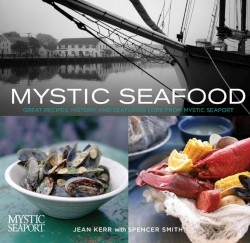Mystic Seafood
Great Recipes, History and Seafaring Lore from Mystic Seaport
- 2006 INDIES Finalist
- Finalist, Cooking (Adult Nonfiction)
Part cookbook and part history lesson, this book is a fish gastronome’s dream. The authors (Kerr is a food writer and editor of Taste Magazine; Smith is a maritime expert who edited Fodor’s Seaside America) pool their talents to produce a volume that’s both entertaining and practical.
The writers divide their project into three distinct areas of creatures indigenous to the Northeast coast: bivalves (oysters, clams, mussels, and scallops); crustaceans (lobster, crab, and shrimp); and “fin fish” (including cod, flounder, haddock, salmon, tuna, and swordfish, among others). After a brief description of each group, Kerr gets down to business.
Just reading the eighty-plus recipe titles can start the mouth to watering: Maine shrimp risotto with prosciutto and peas; oven-roasted cod with lobster, corn, potato, and cream; grilled halibut with nectarine-poblano salsa; and tandoori grilled monkfish. They may sound intimidating, but most of the dishes require fewer than seven steps and, aside from the base ingredient, the remaining items can probably be found in a standard pantry.
Where necessary, instructions for the accoutrements (such as flavored butters or sauces) are included, but there are no recipes or suggestions for side dishes. An easy-to-read note about preparation and cooking times and an index for quick reference would have been useful as well.
Kerr likens Mystic Seaport to a time capsule related to the sea. To that end, rather than the standard photos of the prepared dish (which can often prove frustrating when the version prepared at home doesn’t quite look the same), the book includes elucidating “slice of life” illustrations of fishermen, boats, and regional fishing life.
She also provides anecdotal “fillers” scattered liberally, like savory herbs to add to the flavor of the main course. The lobster, for example, didn’t always enjoy its current reputation as a luxury food item. Kerr writes that such delicacies—some as large as ten pounds—were plentiful in the region as far back as the 1700s and “could feed a good-size family on just one of [them], but you probably wouldn’t even bother to pick it up unless your family was short of food or money. Prosperous people just didn’t eat lobsters. Back then … they were fed to prisoners and indentured servants in lieu of more valuable food such as cod or mackerel.”
She also offers indispensable tips such as how to choose good fish (bottom line: if it smells like fish, don’t buy it) and “how to eat a lobster and maintain your dignity.”
No doubt, after devouring Mystic Seafood, a trip to the fishmonger will be in order.
Reviewed by
Ron Kaplan
Disclosure: This article is not an endorsement, but a review. The publisher of this book provided free copies of the book to have their book reviewed by a professional reviewer. No fee was paid by the publisher for this review. Foreword Reviews only recommends books that we love. Foreword Magazine, Inc. is disclosing this in accordance with the Federal Trade Commission’s 16 CFR, Part 255.

